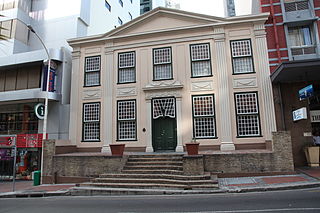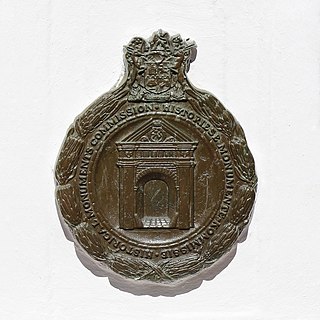
The Castle of Good Hope known locally as the Castle or Cape Town Castle is a bastion fort built in the 17th century in Cape Town, South Africa. Originally located on the coastline of Table Bay, following land reclamation the fort is now located inland. In 1936 the Castle was declared a historical monument and following restorations in the 1980s it is considered the best preserved example of a Dutch East India Company fort.
Leeuwenhof is an estate in the Gardens area of Cape Town, South Africa. It is the official residence of the Premier of the Western Cape. Leeuwenhof was originally a farmhouse dating to the time of the Dutch East India Company's rule of Cape Town. It includes a Slave Quarters which has been renovated and used to house an exhibition about slavery in Cape Town. It was declared a national heritage site on December 15, 1966.

Louis Johannes Tregardt, also spelled Trichardt was a farmer from the Cape Colony's eastern frontier, who became an early voortrekker leader. Shunning colonial authority, he emigrated in 1834 to live among the Xhosa, before he crossed the Orange River into neutral territory. His northward trek, along with fellow trekker Johannes (Hans) van Rensburg, was commenced in early 1836. He led his small party of emigrants, composed of seven Boer farmers, with their wives and thirty-four children, Bushman slaves and Bantu servants, into the uncharted interior of South Africa, and settled for a year at the base of the Zoutpansberg.

Koopmans-de Wet House is a former residence and current museum in Strand Street, Cape Town, South Africa. The house became part of the South African Museum in 1913 and was opened to the public on 10 March 1914. It was declared a National Monument under National Monuments Council legislation on 1 November 1940. It is the oldest house museum in South Africa.

Palm Tree Mosque, or the Church of Jan van Bougies is a former residence and current mosque in Long Street, Cape Town, South Africa. It is the oldest substantially unaltered building in Long Street.
The following is a timeline of the history of Cape Town in the Western Cape province of South Africa.

The Historical Monuments Commission (HMC) was the national heritage conservation authority of South Africa from 1923 to 1969. The HMC was the first such body to be established in South Africa and was the predecessor of the National Monuments Council and therefore also of SAHRA and South Africa's provincial heritage resources authorities. From 1934 onwards the Commission became known principally for its declaration of several hundred historical monuments, later known as 'national monuments' and today as provincial heritage sites.
Jacob Glen Cuyler was an American of Dutch origin who was an important character in the settlement of the British 1820 Settlers to the Eastern Cape, South Africa
Baron Pieter van Reedevan Oudtshoorn was a senior official and Governor designate of the Dutch Cape Colony. He was appointed Governor of the Cape Colony in 1772 to succeed the deceased Governor Ryk Tulbagh but died at sea on his way to the Cape Colony to take up his post. The Western Cape town of Oudtshoorn is named after him. He is the progenitor of the van R(h)eede van Oudtshoorn family in South Africa.

The Treaty Tree is a 500-year-old white milkwood tree on Treaty Road and south of the rail line in Woodstock, Cape Town, South Africa. Peace was made under the tree on 10 January 1806 after the Battle of Blaauwberg, thereby starting the second British occupation of the Cape and leading to the permanent establishment of the Cape Colony as a British possession. Until 1834 slaves were sold and convicts hanged under it.

Queen's Fort Military Museum is a museum in Bloemfontein, South Africa, which depicts all major wars in the Free State from the 1800s. The building was erected in 1848 and put to use for the first time in 1849. Along the years, it has been used as military headquarters, a hospital, an asylum or mental institution, and a prison.
Marthinus Jacobus Oosthuizen was a Voortrekker farmer known for his heroism in battle.

Coornhoop is a historic 17th century farmhouse. It is located at 2 Dixton Road in Observatory, Cape Town. Currently, it houses the Centre for Conflict Resolution.

The Bertram House, located on Hiddingh Campus, of the University of Cape Town on Government Avenue, in Gardens, is the only surviving unpainted red brick two-story house left from early Georgian architecture in the city. The house has a special place in the history of the South African architecture. In 1962, it was declared a national monument, and today remains a provincial heritage site in accordance with the National Heritage Resources Act (25/1999).

The Martin Melck House on 96 Strand Street and the Kostershuis on 100 Strand Street, on either side of the Lutheran Church in Cape Town, are both national heritage sites of South Africa.
Boshofpoort is one of the most well-preserved Cape farm entrances from the 18th century. It is located in Newlands where Boshof Avenue meets Paradise Road (the M3.
Petrus Johannes Kotzé was Mayor of Cape Town and member of the Parliament of the Cape of Good Hope.
Johannes Joachim Lodewyk Smuts was a South African public official, businessman and the second Mayor of Cape Town.

David Christiaan de Waal was a Cape politician, businessman and Mayor of Cape Town.











